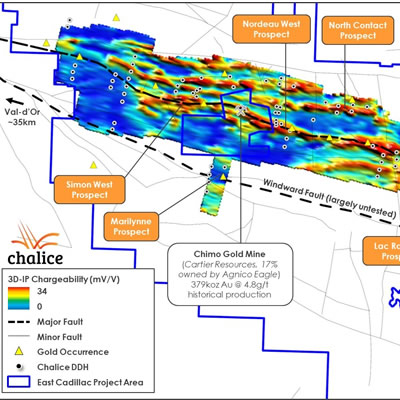Chalice Gold Mines Limited exploration update – East Cadillac Gold Project, Quebec

3D-IP chargeability iso-surface, prospects and Chalice drilling to date. — Photo courtesy Chalice Gold Mines Limited Chalice Gold Mines Limited (ASX:
3D-IP chargeability iso-surface, prospects and Chalice drilling to date. — Photo courtesy Chalice Gold Mines Limited
Chalice Gold Mines Limited (ASX: CHN, TSX: CXN) ("Chalice" or the "Company") is pleased to provide an update on recent reconnaissance drilling, geophysics and targeting activities at the East Cadillac Gold Project in Quebec, Canada (the "Project") which continue to highlight its district-scale gold exploration potential.
An 18-hole, 5,316m reconnaissance diamond drill programme has been completed at two of the seven high-priority prospects identified by Chalice within the Project, Legrand and Anderson, including:
- One 3-hole fence on the Anderson Target; and
- Three 5-hole fences (at ~1km spacing) on the Legrand Target.
Holes were on average 300m deep for sectional reconnaissance coverage. Down-hole wireline surveying (in-situ imaging and geophysical measurements) was completed to assist with ongoing structural interpretation, in preference to standard geo-tech core orientation to reduce costs and to allow more consistent structural orientations in areas of broken core.
Anomalous gold was intersected at both targets, indicating the presence of a gold system. Importantly, drilling at Legrand intersected a significant new untested fault, the Windward Fault, parallel to the Larder Lake Cadillac Fault (LLCF) and interpreted to extend for ~10km west of Legrand.
Chalice Managing Director Alex Dorsch said, "Our focus is now turning to the significant chargeability anomalies east of North Contact and the newly identified Windward Fault, where we believe there is excellent potential to discover large-scale Abitibi-style gold deposits. The shallow mineralisation intersected thus far at North Contact remains open in all directions and the next step is to assess its up-dip and along strike potential."
"Many of the 5Moz+ high-grade deposits on the Cadillac trend are sub-vertically oriented, commence at depths of ~250m and can extend to depths of >2.5km. Given the complete lack of deep drilling on the Project outside of the Simon West – Chimo – Nordeau trend, we believe that testing the depth potential of several advanced prospects is also a logical next step for exploration activity."
"Chalice has now essentially completed the regional scale geochemistry and geophysics work on the Project, and now the next phase of prospect scale exploration begins."
The three Legrand fences intersected a major new fault system (the Windward Fault) within Pontiac sediments containing multiple fault panels of Timiskaming conglomerate and intermediate tuff. Numerous mafic dykes also occur along the fault and along extension planes to the immediate south.
Several lamprophyre dykes intersected in the northernmost drill hole (ECG-19-091) appear to be the eastern extension of lamprophyre dykes in the Lac Rapides target that returned a gold intersection (3.1m @ 4.27g/t Au within 20.8m @ 0.74g/t Au) in the previous (2018) drill programme (refer to Chalice news release dated May 31, 2018).
Widespread quartz-calcite vein arrays with adjacent zones of disseminated pyrite-pyrrhotite-arsenopyrite were identified on all three drill fences. The veining and sulphides are controlled by axial planar structures orientated sub-parallel to the main Windward Fault. Low-grade gold mineralisation was identified along the main fault panel (up to 0.62g/t Au), along extensional structures to the south (up to 1.1 g/t Au) and along the lamprophyre dyke-hosted structure to the north (up to 0.34 g/t Au).
Although the gold grades intercepted to date are low and occur over narrow intervals (up to 2.6m), the identification of previously unrecognised fault panels of Timiskaming conglomerate and intermediate volcaniclastics, together with intrusive dolerite/lamprophyre dykes in the Pontiac sediments, indicate a prospective setting for gold mineralisation outside of the main LLCF corridor.
The elevated gold zones in drill core occur within broader zones of elevated pathfinder elements including Ag, As, Bi, Cs, Cu, Li, Mo, Pb, S, Sb, Te, W & Zn. The pathfinder suite has a similar anomalous response as the MMI soil anomaly, and in terms of maximum and average values, similar or in some cases higher (e.g. Bi, Cs, Cu, Mo, Pb, W, Zn) than what has been observed at the Nordeau West gold deposit (Indicated Mineral Resource of 225,000t @ 4.17g/t Au and Inferred Mineral Resource of 1.11Mt @ 4.09g/t Au).
Similar MMI soil anomalies and one historical gold showing (Marilynne) occur along the 16km long Windward Fault. Other than the current drilling and one reconnaissance fence over the Marilynne showing in 2018, the entire 16km strike length remains largely untested – providing a new trend for exploration on the Project.
Drilling at the Anderson Target identified one narrow zone of orogenic gold mineralisation (up to 0.73 g/t Au) and another narrow zone of gold-rich VMS style mineralization to the south (up to 0.71 g/t Au) from the same assemblage that hosts the Aur Louvem VMS deposit, located approximately 10km to the west. No further work on the Target is planned.
A 116.8 line km 3D-IP survey was completed at 200m/400m line spacing extending the current survey coverage to ~21km of the LLCF as well as ~3km over the new Windward Fault at the Legrand Prospect. An inversion model of the current survey was merged with the 2018 survey and the interpretation of results is ongoing.
From preliminary analysis, the 3D-IP survey has defined several strong chargeability anomalies over the survey area, many of which are extensions to anomalies identified from the 2018 survey.
An anomaly at the eastern end of the Legrand Prospect coincides with the main Windward Fault encountered in the drilling. An additional anomaly to the south of the Windward Fault appears to be a new sub-parallel fault and was not tested by the 2019 drilling.
The 2019 survey has also extended the main chargeability anomaly along the LLCF an additional 4.5km east and delineated an extension to the North Contact chargeability anomaly another 3km east of the 2017-2018 survey. Additional interpretation work is underway on an inversion model to refine these targets.
New targeting and planning activities are underway on five priority Prospects on the Project – North Contact, Lac Rapides, Simon West, Nordeau West and Legrand. Two additional targets – Marquise and Makwa, remain untested and require further in-fill geochemical sampling to refine (refer to Chalice news release dated October 25, 2018).
This follow-up activity is intended to build on previously identified mineralised zones from the reconnaissance drilling by Chalice to date.
It is expected that all additional results from ongoing activities, including structural data from wireline logging, multi-element geochemistry, spectral scanning of selected drill core and thin section description of alteration assemblages, will be incorporated into a comprehensive targeting review to assist with prioritising work programmes over these key Prospects.
As part of this review, the potential for shallow, open-pit style mineralisation at the North Contact and Simon West Prospects is being investigated. The Company anticipates that this targeting work will be completed by mid-May 2019.
The East Cadillac Gold Project covers an area of 233km2 and is located 35km east of the Val-d'Or gold camp in Quebec, Canada. With land holdings encompassing a strike length of 27km of the Larder Lake-Cadillac Fault (LLCF), the most prolifically endowed gold trend in the southern Abitibi, the Project is along strike from several globally significant mines including Canadian Malartic and Sigma Lamaque.
The Project surrounds the historic Chimo gold mine, owned by Cartier Resources (TSX: ECR), which produced ~379koz @ 4.8g/t Au, down to ~800m below surface. Drilling by Cartier and 17% owner Agnico Eagle have resulted in significant extensions to mineralisation below historic workings, with the potential to plunge onto Chalice's claims at depth.
Acquired in late 2016, the Project is a consolidation of several earn-in option agreements (Chalice earning 80 to 100%) and Chalice's 100%-owned claims. Previously segmented ownership hindered any modern regional exploration being applied effectively, meaning the Project is underexplored relative to the remainder of the LLCF trend.
Since acquiring the Project, Chalice has completed systematic geochemistry and geophysics field programmes, targeting a 5Moz+ discovery. This work has generated 7 new, large-scale targets. Chalice has drilled ~35,000m to date on the Project, testing 5 of these new targets resulting in 3 new wide-open discoveries. Drilling has also expanded two existing advanced prospects along strike and down plunge.




